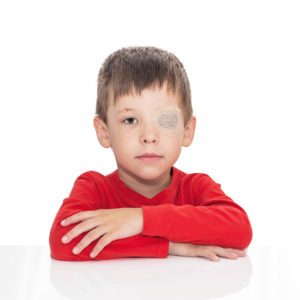One of the most common topics discussed in the realm of pediatrics and binocular vision is amblyopia. Amblyopia is a visual disorder in which a lack of proper visual input during development impairs the visual pathway, resulting in decreased visual acuity. When it comes to treating amblyopia, an oftentimes controversial discussion revolves around patching.
 Patching is a method of amblyopia treatment in which the “stronger” eye is patched so that the “weaker” eye is forced to break any suppression and use its visual pathway. The idea is that patching works on the neuroplasticity of the brain in order to create new neural connections and retrain the visual system to use both eyes equally. Patching is still used by many eye doctors today; however, many also try their best to avoid it. This is why the studies done by the Pediatric Eye Disease Investigator Group (PEDIG) known as the Amblyopia Treatment Studies (ATS) are crucial to understand so that you can make your own informed decisions about amblyopia treatment using evidence based treatment. These prospective, well-designed multi-center studies provide support for treatment and management of amblyopia that is safe and effective for your patients.
Patching is a method of amblyopia treatment in which the “stronger” eye is patched so that the “weaker” eye is forced to break any suppression and use its visual pathway. The idea is that patching works on the neuroplasticity of the brain in order to create new neural connections and retrain the visual system to use both eyes equally. Patching is still used by many eye doctors today; however, many also try their best to avoid it. This is why the studies done by the Pediatric Eye Disease Investigator Group (PEDIG) known as the Amblyopia Treatment Studies (ATS) are crucial to understand so that you can make your own informed decisions about amblyopia treatment using evidence based treatment. These prospective, well-designed multi-center studies provide support for treatment and management of amblyopia that is safe and effective for your patients.
Glasses alone can improve amblyopia. The first line of treatment is prescribing a spectacle prescription if warranted. The studies have found that optimal spectacles can lead to improvements in vision in children with anisometropic amblyopia, strabismic amblyopia, bilateral refractive amblyopia, and combined mechanism amblyopia, and these improvements are more significant if the children are younger or have better baseline VA.
Additional treatment with patching, atropine, or a Bangerter filter can then be initiated if amblyopia persists. Before the ATS studies, there was no consensus about the number of hours amblyopic patients should be patched and full time occlusion was often recommended. There was also no consensus on the dosage of atropine, and its efficacy compared to patching. The ATS studies have found that both patching and atropine are effective treatments for amblyopia, and provide us with recommendations for treatment based on amblyopia severity and patient age. PEDIG has defined amblyopia as mild (20/30 or better), moderate (20/40-20/80), and severe (20/100-20/400).
- Hours of patching recommended for children ages 3-7:
- Moderate amblyopia: patch 2 hours a day (similar in efficacy to patching 6 hours a day)
- Severe amblyopia: patch 6 hours a day (similar in efficacy to full time patching); may respond to 2 hours a day
- Dosing of atropine recommended for children ages 3-12:
- Moderate amblyopia: weekend atropine (similar to in efficacy to daily atropine)
- Additional findings:
- When the VA in the amblyopia eye stops improving with 2 hours of patching, increase the hours of patching to 6 hours for children aged 3 to 7.
- For children aged 7-12, prescribing patching can improve VA even if amblyopia has been previously treated.
- For older children aged 13-17, prescribing patching can improve VA when amblyopia has NOT been previously treated.
- Performing near activities does not improve VA when treating amblyopia with patching. Other visual functions were not studied, thus the benefit of near activities on other visual functions including accommodation, pursuit, saccades, and eye and hand coordination are unknown
- There is a risk of recurrence of amblyopia after stopping treatment with patching or atropine, especially within the first three months. Recurrence risk is low when 2 hours of patching is stopped, and is more common when patching is not tapered from 6 or more hours. Thus patients should be tapered to 2 hours before stopping treatment.
That’s not all – PEDIG is investigating binocular iPad games vs patching (ATS 18), PRK for anisometropic amblyopia (ATS 19), and binocular dig rush game on iPad game plus spectacles vs spectacles alone (ATS 20). More questions? Check out the ATS studies that have been completed thus far: http://pedig.jaeb.org/publications.aspx.
A good understanding of the research is crucial to providing the best care for your amblyopic patients. Treatment is dependent on a many factors such as the severity of amblyopia, age of the patient, and parental and patient motivation. Early intervention is key! Know when to treat and if you don’t feel comfortable, refer to an OD who does. For more information on pediatric exams, check out the AOA’s Evidence Based Pediatric Vision Exam Clinical Practice Guideline.
Special thanks to our Senior Editor Jessica Chan for her help in writing this article!

